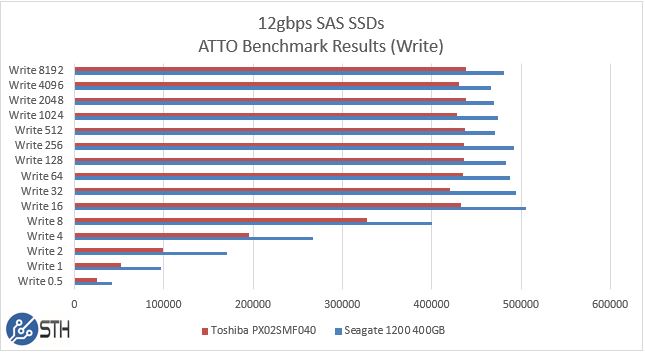Today we are putting the Seagate 1200 400GB SAS SSD through our quick benchmarks. The actual model name is the Seagate ST400FM0013 for these drives, but they are from the 1200 series. Over the past few months we have been building a data set around SAS SSDs and admittedly, these are a late entry. We have been finding some interesting differences in performance thus far and we are going to have an interesting finding today. The Seagate 1200 series of SAS SSDs are 12gbps capable drives that were a major update to the Pulsar.2 line which we previously benchmarked.
For reference here are the previously published SAS quick benchmarks:
Single SAS SSD Benchmarks
- Pliant/ SanDisk Lightning 206s 200GB SLC SAS SSD benchmarks
- Seagate Pulsar.2 200GB MLC SAS SSD benchmarks
- Pliant/ SanDisk Lightning 406s 400GB SLC SAS SSD benchmarks
- Smart Storage System/ SanDisk Optimus 400GB MLC SAS SSD benchmarks
- Samsung SM1625 200GB SAS SSD benchmarks
- Toshiba PX02SMF080 800GB SAS SSD benchmarks
- Toshiba PX02SMF040 400GB SAS SSD benchmarks
2 Drive RAID 0 Benchmarks
- 2x SanDisk Lightning 206s 200GB SAS SSD benchmarks
- 2x Seagate Pulsar.2 200GB SAS SSD benchmarks
- 2x Smart Storage System/ SanDisk Optimus 400GB MLC SAS SSD benchmarks
- 2x SanDisk Lightning 406s 400GB SAS SSD benchmarks
- 2x Samsung SM1625 200GB SAS SSD benchmarks
Our goal is to continue posting one more per week in-between other articles and have started publishing enterprise SATA drive results also over the past few weeks.
Test Configuration
Since we are going to assume the use of already released hardware, we are using a legacy system for testing across the test suite given that we started the process before the Haswell-EP parts became available.
- Motherboard: Gigabyte GA-7PESH3
- Processors: Dual Intel Xeon E5-2690 (V2)
- SAS Controller: LSI SAS 3008
- RAM: 64GB DDR3L-1600MHz ECC RDIMMs
- OS SSD: Kingston V300 240GB
We are using a SAS controller so one cannot compare results directly to consumer-driven setups where a SATA SSD is connected to an Intel PCH port. There is a latency penalty for going over the PCIe bus to a controller to SAS. It also is a reason NVMe is going to be a game changer in the enterprise storage space.
One major note: we have been testing drives using a single-port configuration. That has little impact on some drives (e.g. the Toshiba PX02SMF series) but has significant impacts on some drives like the Seagate 1200 as we will see.
Seagate 1200 400GB SSD Quick Benchmarks
For our quick tests during this part of the series we will just provide the quick benchmarks with only a bit of commentary. The results should be fairly straightforward and the index of previous articles in this series (linked above) is a good resource to compare against. We are also adding the results for the Toshiba PX02SMF040 which is another 400GB 12gbps SAS SSD.
AS SSD Benchmark
AS SSD is a solid benchmark that does not write compressible data to drives. The result is perhaps one of the best workstation SSD benchmarks available today.
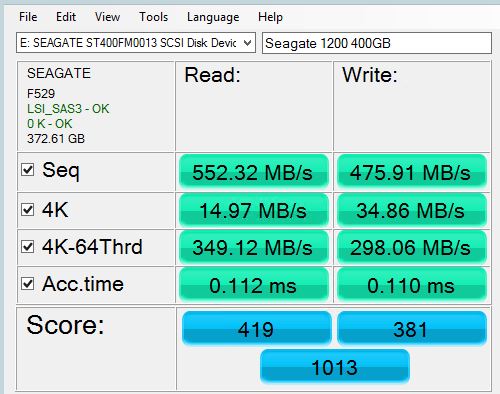
The Seagate ST400FM0013 here shows speeds that look more like SAS2 speeds. We did verify the link to the controller was at 12gbps. We made a few calls after the results and found out that peak performance occurs with multipath I/O via a dual ported connection to the drive.

As we compare it to the Toshiba offering, we can see the impact of the single port configuration. Still, these drives are much faster than the SanDisk Lightning lb406s SLC SAS SSDs we tested.
CrystalDiskMark
CrystalDiskMark is another benchmark which gives non-compressible read/write numbers. This is in contrast to the ATTO Benchmark used by LSI/ Sandforce and its partners when they market a given solid state drive.
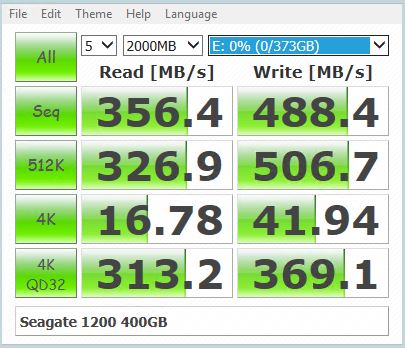
Again, there are practical limits set by the single-ported configuration.
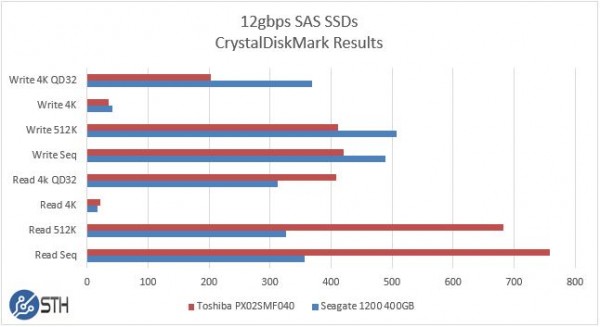
Here we see that the 4K read is similar to the Toshiba but CrystalDiskMark produces across-the-board faster figures for the Seagate ST400FM0013.
ATTO Benchmark
The value of the ATTO benchmark is really to show the best-case scenario. ATTO is known to write highly compressible data to drives, which inflates speeds of controllers that compress data like LSI/ SandForce does prior to writing on a given solid state drive.
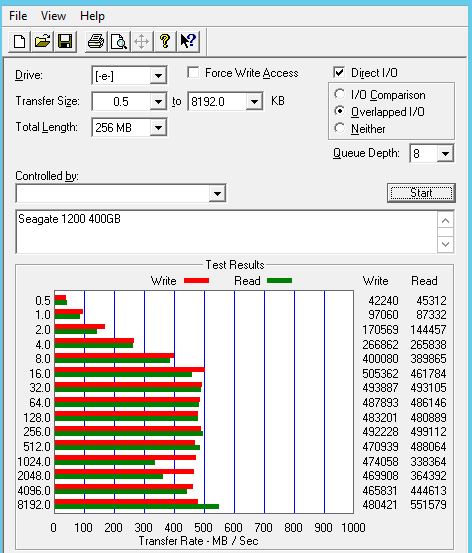
Here is an interesting note that we saw a few times. It seems as though the drive is optimized for lower-size read/ writes.
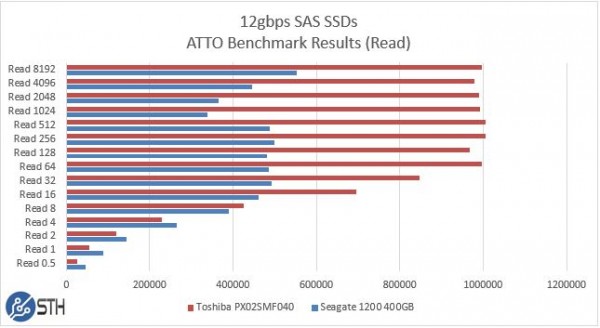
Comparing the Seagate 1200 (ST400FM0013) to the Toshiba PX02SMF040 we can see that the 4K and below figures favor the Seagate offering.

On the write side, the Seagate ST400FM0013 is faster across the board.
Conclusion
This is certainly one of the more interesting sets of results we have. We do have an expansion chassis with a dual-ported backplane that we may use on future tests just to test what we have heard, that these drives are built for dual-ported applications. More to come on the longer-term testing including latency figures as we start publishing those results in the next few weeks.

